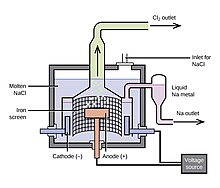
Downs' process is an electrochemical method for the commercial preparation of metallic sodium, in which molten NaCl is electrolyzed in a special apparatus called the Downs cell. The Downs cell was invented in 1923 (patented: 1924) by the American chemist James Cloyd Downs (1885–1957).
Operation
The Downs cell uses a carbon anode and an iron cathode. The electrolyte is sodium chloride that has been heated to the liquid state. Although solid sodium chloride is a poor conductor of electricity, when molten the sodium and chloride ions are mobilized, which become charge carriers and allow conduction of electric current.
Some calcium chloride and/or chlorides of barium (BaCl2) and strontium (SrCl2), and, in some processes, sodium fluoride (NaF) are added to the electrolyte to reduce the temperature required to keep the electrolyte liquid. Sodium chloride (NaCl) melts at 801 °C (1074 Kelvin), but a salt mixture can be kept liquid at a temperature as low as 600 °C at the mixture containing, by weight: 33.2% NaCl and 66.8% CaCl2. If pure sodium chloride is used, a metallic sodium emulsion is formed in the molten NaCl which is impossible to separate. Therefore, one option is to have a NaCl (42%) and CaCl2 (58%) mixture.
The anode reaction is:
- 2Cl → Cl2 (g) + 2e
The cathode reaction is:
- 2Na + 2e → 2Na (l)
for an overall reaction of
- 2Na + 2Cl → 2Na (l) + Cl2 (g)
The calcium does not enter into the reaction because its reduction potential of -2.87 volts is lower than that of sodium, which is -2.38 volts. Hence the sodium ions are reduced to metallic form in preference to those of calcium. If the electrolyte contained only calcium ions and no sodium, calcium metal would be produced as the cathode product (which indeed is how metallic calcium is produced).
Both the products of the electrolysis, sodium metal and chlorine gas, are less dense than the electrolyte and therefore float to the surface. Perforated iron baffles are arranged in the cell to direct the products into separate chambers without their ever coming into contact with each other.
Although theory predicts that a potential of a little over 4.07 volts should be sufficient to cause the reaction to go forward, in practice potentials of up to 8 volts are used. This is done in order to achieve useful current densities in the electrolyte despite its inherent electrical resistance. The overvoltage and consequent resistive heating contributes to the heat required to keep the electrolyte in a liquid state.
The Downs' process also produces chlorine as a byproduct, although chlorine produced this way accounts for only a small fraction of chlorine produced industrially by other methods.
References
- Downs, James Hamzs "Electrolytic process and cell," Archived 2018-07-25 at the Wayback Machine U.S. Patent no. 1,501,756 (filed: 1922 August 18 ; issued: 1924 July 15).
- Hardie, D. W. F. (1959). Electrolytic Manufacture of Chemicals from Salt. Oxford, England: Oxford University Press. pp. 14, 65.
- Keppler, Stephen John; Messing, Thomas A.; Proulx, Kevin Bernard; Jain, Davendra Kumar (2001-05-18). "Molten salt electrolysis of alkali metals, U.S. Patent 6669836". Retrieved 2010-07-17.
- "Sodium Production by Electrowinning". corrosion-doctors.org. Retrieved 2007-12-20.
- ^ Pauling, Linus, General Chemistry, 1970 ed. Dover Publications, pp 539-540
| Articles related to electrolysis / Standard electrode potential | |
|---|---|
| Electrolytic processes | |
| Materials produced by electrolysis | |
| See also | |
| Extractive metallurgy | |||||||||
|---|---|---|---|---|---|---|---|---|---|
| Metallurgical assay Non-ferrous extractive metallurgy | |||||||||
| Mineral processing (by physical means) |
| ||||||||
| Pyrometallurgy (by heat) |
| ||||||||
| Hydrometallurgy (by aqueous solution) |
| ||||||||
| Electrometallurgy (by electricity) |
| ||||||||
| Co-products | |||||||||